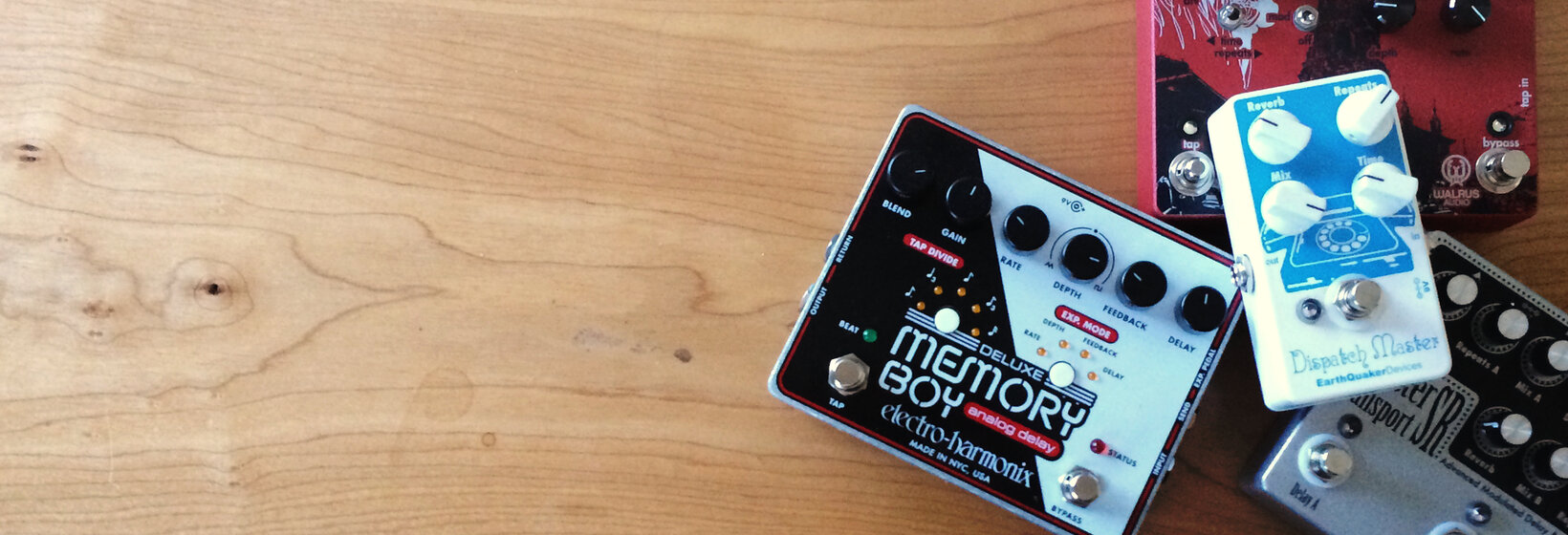
How to Choose the Right Delay Setting for Your Guitar
The three parameters that really matter.
Guitar tone is all about creativity and taste.
We give you a tone chapter in every guitar lesson to help you match the effects used on the recording, but ultimately it's up to you to dial in the sound you want. In this post we are going to look at some general parameters of delay. These aren't meant to be a catch-all for choosing delay settings, but more of a suggested starting point for you to explore delay-cious soundscapes.
There are three parameters that really matter when setting up your delay pedals and tone - timing, feedback, and mix. We are going to focus on those three considerations for delay settings, and look at each deloay timing where they can be applied. If you aren't familiar with timing, feedback, and mix, we will discuss these terms in greater detail here. Let's break them down for delay timing.
Quarter Note delay
Quarter note delays are great for any time you are working with long legato leads, spacious ambient parts, volume swells, and windmill chords. Generally, we like them to keep them somewhat low in the mix and have them trail off by the end of a measure. The louder they are, the more unwieldy they can get, keep the volume low to fatten the sound. The exception is with reverb-heavy ambient sections. Then it can be nice to keep quarter note delays low in the mix, but let them trail for a few measures to create a nice bed behind the lead parts.
Eighth Note Delay
Eighth note delays are great for filling out eighth note parts, and we all know there are plenty of those. Droning down strums, alternate picking, and faster runs can all benefit from this delay setting on a lead guitar. In general, you can treat your mix the same as you do for quarter notes -- more subtle delays that trail off by the end of the measure.
Dotted Eighth Note Delay
Pink Floyd's use of dotted eighth delay in "Run Like Hell" is one of the more famous uses, not to mention U2's "I Still Haven't Found What I'm Looking For," which popularized dotted eighth delay even further. And then, of course, it was overused by every worship guitarist ever. The dotted eighth delay is probably the most recognizable of the delay settings for lead guitar. It is also the most challenging delay to get right. Nevertheless, it has its place. While quarters and eighths tend to blend more, dotted eighth delays always create a feeling of movement. It gives your playing a galloping feel with lots of emotion behind it.
If you don't have a delay that has a dotted eighth subdivision, tapping or setting this delay can be tricky. Here's where your taps need to fall for this delay:

I have two basic uses for this one. The first is simply a subtle low volume delay that fades by the end of the first measure. Sometimes it just "feels right." The second is a more pronounced rhythmic delay, which you are used to hearing. To make this work, you want to set your mix so the delay is just as loud as your initial note, but trails off after only 1 or 2 repeats. If you don't set your feedback short enough, this delay can get away from you and make your tone sound muddy.
Now that we've gone over the essentials of timing, feedback, and mix for the quarter note, eighth note, and dotted eighth note, let's hear how they sound in this video from Worship Artistry's lead guitar instructor, Jason.
Conclusion
Keep in mind that there really are no right and wrong delay pedal settings. It all depends on what you think sounds and feels best. Treat your delay settings like another instrument and let your creativity run wild. You may find a delay setting that truly defines your sound. We'd love to hear how you set your pedals, so comment below if you have other great ideas!
Comments
what is the
Submitted by Heartfelt worsh... on October 1, 2015 - 8:16am.
delay pedal your using in the video?
It's an empress effects tape delay
Submitted by Jason Houtsma on October 1, 2015 - 2:29pm.
I've got a demo coming soon
Nice overall post. Would
Submitted by Nick Nelson on October 1, 2015 - 9:30am.
Nice overall post. Would liked to have seen non-meter based suggestions also though.
Perhaps
Submitted by Jason Houtsma on October 1, 2015 - 2:29pm.
A part two is in order?